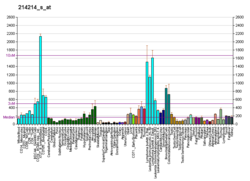C1QBP
보체 구성 요소 1 Q 하위 구성 요소 결합 단백질, 미토콘드리아(Complement component 1 Q subcomponent-binding protein, mitochondrial)는 인간에서 C1QBP 유전자에 의해 암호화되는 단백질이다.[5][6][7]
인간 보체 하위 구성 요소 C1q는 혈청 보체 시스템의 첫 번째 구성 요소를 생성하기 위해 C1r 및 C1과 결합한다. 이 유전자에 의해 암호화된 단백질은 C1q 분자의 구형 머리부분에 결합하여 C1 활성화를 억제하는 것으로 알려져 있다. 또 이 단백질은 히알루론산 결합 단백질 뿐만 아니라 pre-mRNA 스플라이싱 인자 SF2의 p32 소단위체으로 확인되었다.[7]
단백질 소단위체[편집]
C1QBP는 길이가 282개인 아미노산이고, N 말단에 73개 아미노산 잔기가 절단되어 성숙한 C1QBP를 생성하는 3개의 상동 소단위체가 있다. C1QBP는 환원 및 비환원 조건 모두에서 폴리아크릴아마이드 겔에서 약 33kDa의 단량체로 나타나지만 크기 배제 크로마토그래피(겔 여과) 에서는 삼량체로 이동한다.[8]
단백질 구조[편집]
2.25Å 분해능에서 C1QBP의 결정 구조는 대칭성을 나타내는 동종삼량체 고리를 보여준다. 개별 소단위는 비공유 상호작용에 의해 함께 유지되고 직경이 20Å인 중심 공동이 있는 도넛 모양의 4차 구조를 형성한다. C1QBP의 각 소단위체에는 7개의 베타 병풍 구조(β1-β7)과 3개의 알파 나선 구조(α1-α3)가 있다. C1QBP는 용해성 면에서 음전하를 띠는 반면 막 면은 주로 양전하를 띠고 있다.[9]
상호작용[편집]
C1QBP는 단백질 인산화효소 D1[10], BAT2[11], PRKCD[10], PKC 알파[10] 및 단백질 인산화효소 Mζ[10]와 상호 작용 하는 것으로 나타났다. C1QBP의 다른 상호 작용 파트너에는 세균[12], 바이러스[13] 및 변형체 열원충(plasmodium falciparum)[14]과 같은 병원체의 단백질 도메인이 포함된다. 피브리노겐, FXII 및 HK를 포함한 혈장 단백질은 아연 의존적 방식으로 C1QBP와 상호작용하는 것으로 입증되었다.[15][16] 최근 종양 유도 펩타이드인 LyP-1(CGNKRTRGC)은 종양 발현 세포에서 C1QBP에 선택적으로 결합하는 것으로 나타났다.[17]
각주[편집]
- ↑ 가 나 다 GRCh38: Ensembl release 89: ENSG00000108561 - 앙상블, May 2017
- ↑ 가 나 다 GRCm38: Ensembl release 89: ENSMUSG00000018446 - 앙상블, May 2017
- ↑ “Human PubMed Reference:”. 《National Center for Biotechnology Information, U.S. National Library of Medicine》.
- ↑ “Mouse PubMed Reference:”. 《National Center for Biotechnology Information, U.S. National Library of Medicine》.
- ↑ “Molecular cloning of human fibroblast hyaluronic acid-binding protein confirms its identity with P-32, a protein co-purified with splicing factor SF2. Hyaluronic acid-binding protein as P-32 protein, co-purified with splicing factor SF2”. 《J Biol Chem》 271 (4): 2206–12. March 1996. doi:10.1074/jbc.271.4.2206. PMID 8567680.
- ↑ “Isolation, cDNA cloning, and overexpression of a 33-kD cell surface glycoprotein that binds to the globular "heads" of C1q”. 《J Exp Med》 179 (6): 1809–21. June 1994. doi:10.1084/jem.179.6.1809. PMC 2191527. PMID 8195709.
- ↑ 가 나 “Entrez Gene: C1QBP complement component 1, q subcomponent binding protein”.
- ↑ Jiang, Jianzhong (1999). “rystal structure of human p32, a doughnut-shaped acidic mitochondrial matrix protein”. 《PNAS》 96 (7): 3572–3577. Bibcode:1999PNAS...96.3572J. doi:10.1073/pnas.96.7.3572. PMC 22335. PMID 10097078.
- ↑ Jiang, Jianzhong (1999). “rystal structure of human p32, a doughnut-shaped acidic mitochondrial matrix protein”. 《PNAS》 96 (7): 3572–3577. Bibcode:1999PNAS...96.3572J. doi:10.1073/pnas.96.7.3572. PMC 22335. PMID 10097078.
- ↑ 가 나 다 라 Storz, P; Hausser A; Link G; Dedio J; Ghebrehiwet B; Pfizenmaier K; Johannes F J (August 2000). “Protein kinase C [micro] is regulated by the multifunctional chaperon protein p32”. 《J. Biol. Chem.》 (UNITED STATES) 275 (32): 24601–7. doi:10.1074/jbc.M002964200. ISSN 0021-9258. PMID 10831594.
- ↑ Lehner, Ben; Semple Jennifer I; Brown Stephanie E; Counsell Damian; Campbell R Duncan; Sanderson Christopher M (January 2004). “Analysis of a high-throughput yeast two-hybrid system and its use to predict the function of intracellular proteins encoded within the human MHC class III region”. 《Genomics》 (United States) 83 (1): 153–67. doi:10.1016/S0888-7543(03)00235-0. ISSN 0888-7543. PMID 14667819.
- ↑ Braun, Laurence; Ghebrehiwet, Berhane; Cossart, Pascale (2000). “gC1q-R/p32, a C1q-binding protein, is a receptor for the InlB invasion protein of Listeria monocytogenes”. 《The EMBO Journal》 19 (7): 1458–1466. doi:10.1093/emboj/19.7.1458. PMC 310215. PMID 10747014.
- ↑ Kittlesen, David J.; Chianese-Bullock, Kimberly A.; Yao, Zhi Q; Braciale, Thomas J.; Hahn, Young S. (2000). “Interaction between complement receptor gC1qR and hepatitis C virus core protein inhibits T-lymphocyte proliferation”. 《J Clin Invest》 106 (10): 1239–1249. doi:10.1172/jci10323. PMC 381434. PMID 11086025.
- ↑ Magallón-Tejada, Ariel (2016). “Cytoadhesion to gC1qR through Plasmodium falciparum Erythrocyte Membrane Protein 1 in Severe Malaria”. 《PLOS Pathog》 12 (11): e1006011. doi:10.1371/journal.ppat.1006011. PMC 5106025. PMID 27835682.
- ↑ Pathak, Monika; Kaira, Bubacarr G.; Slater, Alexandre; Emsley, Jonas (2018). “Cell Receptor and Cofactor Interactions of the Contact Activation System and Factor XI”. 《Frontiers in Medicine》 5: 66. doi:10.3389/fmed.2018.00066. PMC 5871670. PMID 29619369.
- ↑ Peerschke, EI; Bayer, AS; Ghebrehiwet, B; Xiong, YQ (2006). “gC1qR/p33 blockade reduces Staphylococcus aureus colonization of target tissues in an animal model of infective endocarditis”. 《Infect Immun》 74 (8): 4418–4423. doi:10.1128/iai.01794-05. PMC 1539591. PMID 16861627.
- ↑ Paasonen, Lauri; Sharma, Shweta; Braun, Gary B.; Kotamraju, Venkata R.; Chung, Thomas D.Y.; She, Zhigang; Sugahara, Kazuki N; Yliperttula, Marjo; Wu, Bainan (2017). “New p32/gC1qR Ligands for Targeted Tumor Drug Delivery”. 《ChemBioChem》 17 (7): 570–575. doi:10.1002/cbic.201500564. PMC 5433940. PMID 26895508.







